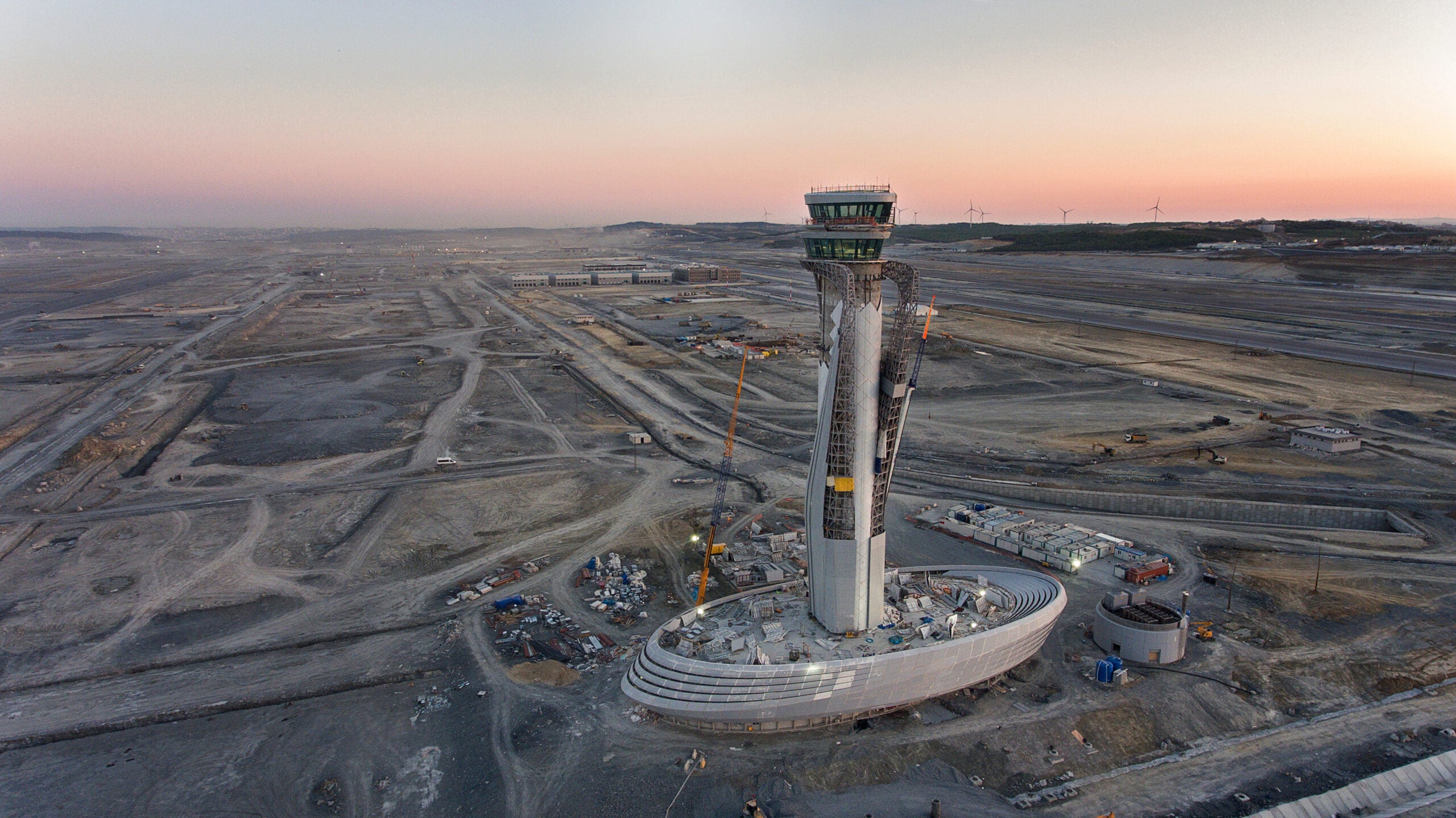
Mega Projects: Most Expensive Airport in the World
In total, 159 airport construction projects broke ground over the last year. These projects have a combined value of almost $110bn, a slight decrease on the 134 projects that cost £131bn in 2020. 59% of all projects in the last year are based on terminals, either expansions or new developments, totalling over $87bn investment combined.
Of the ten most expensive airport projects that entered the execution phase in 2021, seven are located in Asia, proving the rapid growth of aviation in the region.
Read our updated list of the ten most expensive airport construction projects of 2023 here.

Discover B2B Marketing That Performs
Combine business intelligence and editorial excellence to reach engaged professionals across 36 leading media platforms.
More locally, the Philippines is the only country to feature twice on this list, showcasing a rapid expansion based on the relatively small size compared to other countries that feature.
Here are the top ten most expensive airport construction projects that broke ground in 2021.

Navi Mumbai International Airport, India: $2.3bn
Adani Airport Holdings, a subsidiary of Adani group and Airports Authority of India, is undertaking the construction of an airport in Navi Mumbai, Maharashtra, India. The project has been proposed to meet the growing demand for air travel, with the existing airport in Mumbai fast reaching saturation level.
The new airport would be one of the world’s few ”Greenfield” international state-of-art airports offering world-class facilities. It will be capable of handling 60 million passengers a year by 2030 when it reaches full capacity.
The terminal building will cover over a 523,000m2 area. The main terminal buildings will have five levels, including two mezzanine floors and 350 check-in counters. The cargo complex will get around the 201,58m2 area while the fueling enclave will get a 151,000m2 area.

US Tariffs are shifting - will you react or anticipate?
Don’t let policy changes catch you off guard. Stay proactive with real-time data and expert analysis.
By GlobalDataThe project includes the construction of non-aeronautical activities, such as hotels and commercial plazas, which will be spread across the 276ha area. The airport will have parking availability for 5,500 cars, 3,500 bikes, 120 buses, and 10 cargo trucks.
Shannan Longzi Airport, Tibet: $2.5bn
The Tibet Autonomous Regional Administration of CAAC is constructing an airport development project on a site area of 5ha in Shannan, Tibet Autonomous Region. The project aims to increase passenger handling capacity to provide the region with better transport facilities.
The project involves the construction of a terminal building with a floor area of 6,000m2, a 4,500m runway, hangars, taxiways, and an aircraft maintenance centre.
It will also entail the building of an air traffic control tower, lounges, retail facilities, control rooms, office facilities, and parking facilities. As well as this, the project will also include the installation of security systems.
San Diego Airport Upgrade, US: $2.6bn
The San Diego International Airport is planning a major airport upgrade. A new terminal with 19 gates will be constructed and the old terminal will then be demolished at the airport in California, US.
The project includes the construction of 30 gates, on-and off-ramps, an access road adjacent to North Harbor Drive, an airport transit station, bike lanes, upgrades to terminal one, and the installation of safety and security systems.
Fuzhou Changle International Airport Expansion, China: $3.1bn
Yuanxiang (Fuzhou) International Airport Co. is expanding Changle International Airport on a site area of 310ha in Fuzhou, Fujian, China. The project aims to enhance the capacity of the airport, and provide better facilities to both domestic and international passengers.
The project involves the construction of a 45m wide, 3.6km long runway. It will also entail building a new 255,000m2 terminal, 60 hangers, an 80,000m2 transportation centre, a 25,000m2 freight station, a taxiway, cafes, and restaurants.
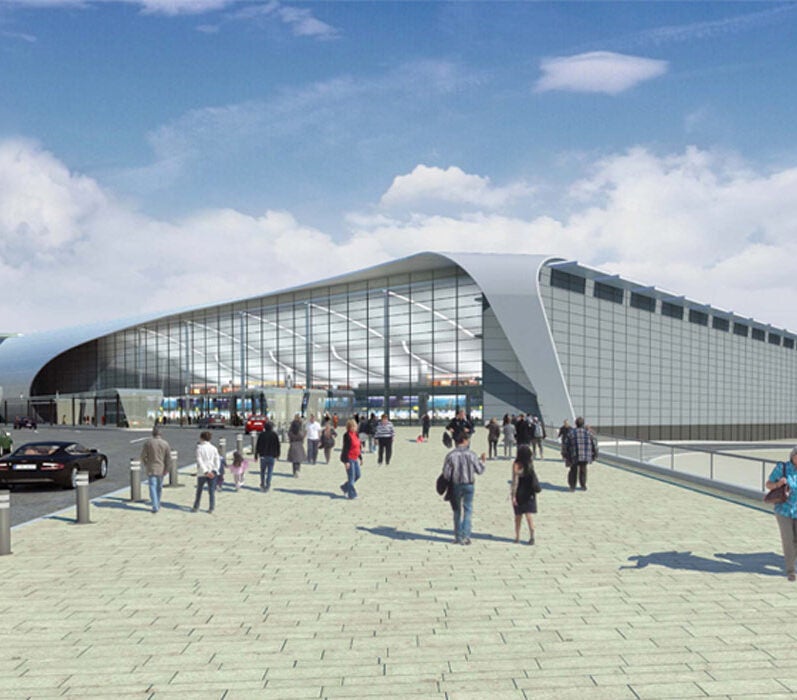
Domodedovo International Airport Expansion, Russia: $3.2bn
The East Line Group is undertaking the expansion of Domodedovo International Airport in Moscow, Russia. The project will ease air traffic congestion and enhance airport annual capacity from 30 million to 35 million passengers.
The objective of the project is to establish the airport as a major international and multi-modal transportation hub and create a larger space for the check-in area and departure gates
The Domodedovo International Airport project involves the expansion of the T1 passenger terminal and the construction of two new passenger terminals: T2 and T3. It also entails the building of a new runway, redevelopment of the air traffic control tower and runway-1, and the installation of new operational and management technology systems.
Western Sydney Airport, Australia: $3.5bn
The Department of Infrastructure and Regional Development, through Western Sydney Airport Ltd, is undertaking the construction of an airport in New South Wales, Australia. The main aim of the project is to accommodate more international flights and flexible runways for the planes. Sydney airport is already facing capacity issues and the requirement of a second airport is essential in the region to handle the traffic.
The project involves the construction of an airport on 1,780ha of land and is planned to be implemented in stages. The construction work is divided into two development phases, enabling activities and the main airport works.
The first stage includes the construction of a 3.7km single east-west runway with a width of 60m, a single full-length parallel taxiway, a cargo terminal, apron, and a 65,000m2 international and domestic terminal with a capacity of 10 million passengers a year.
It also entails building a 35m height air traffic control tower, parking facilities for around 11,500 cars, and the installation of 3000 aeronautical ground lights and safety and security systems. The terminal will include a public plaza, shops, restaurants and cafes, and will be connected to the local transport network by the M12 motorway.
The Western Sydney Airport project also includes the construction of a 40km access road, a surface water drainage facility, airside security fencing and landscaping, ticket and service counters and, aerobridges. Furthermore, it will involve the construction of a baggage handling system, an arrival and a departure lounge, rail infrastructure, offices, and the installation of escalators.
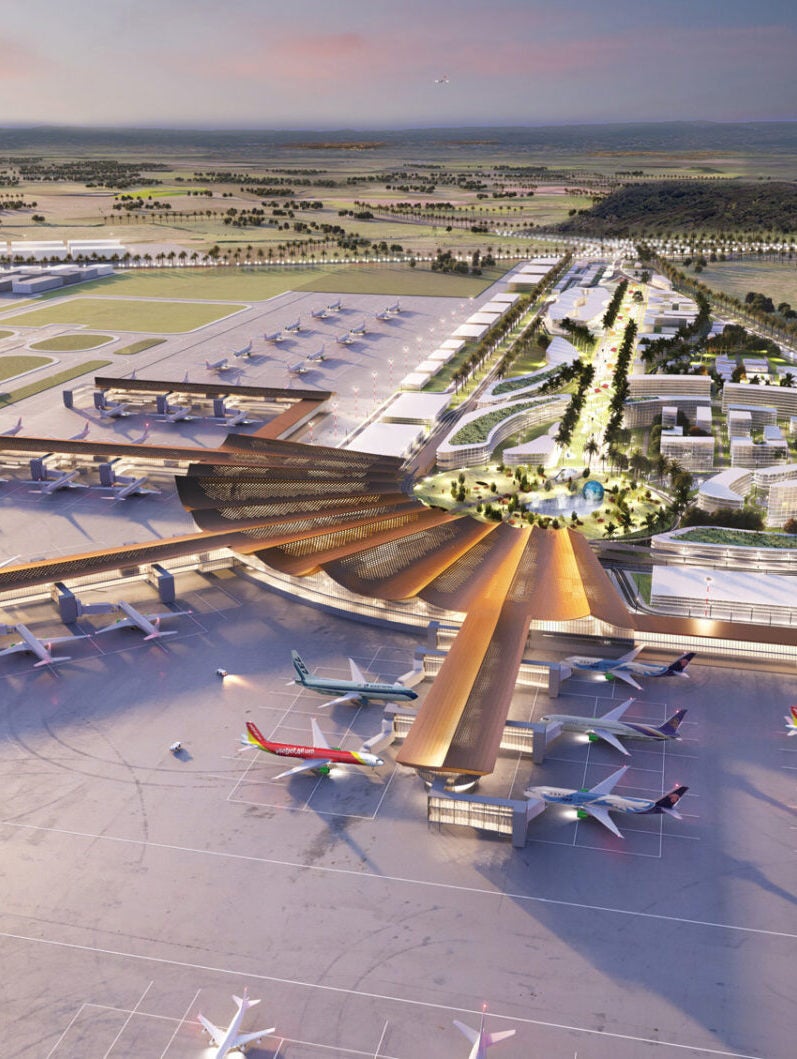
U-Tapao International Airport Expansion, Thailand: $9.3bn
The Thailand Ministry of Transport, through Airports of Thailand, is undertaking the expansion of the U-Tapao international airport in Rayong, Thailand. The aim of the project is to ease traffic loads at Bangkok’s Suvarnabhumi International Airport and boost tourism in the region.
The project involves the expansion of the U-Tapao airport to accommodate 60 million passengers on 1,040ha of land. It is being developed in four phases.
Phase I involves the construction of a 157,000m2 terminal, with commercial areas and 60 parking bays to accommodate 15.9 million passengers per year. It is expected to be completed by 2024. Phase II includes the construction of a 107,000m2 second terminal building, with an automated people mover (APM) system and 16 additional parking bays. It will be able to accommodate 30 million passengers annually and is expected to be completed by 2030.
Phase III involves the construction of a 107,000m2 extension to the second terminal building with an APM system, as well as 34 additional parking bays. Expected to be completed by 2043, it aims to accommodate 45 million passengers annually.
Finally, Phase IV will see the construction of an 82,000m2 extension to the second terminal building with an APM system, as well as 18 additional parking bays. It can accommodate 60 million passengers annually and is scheduled to be completed by 2055.
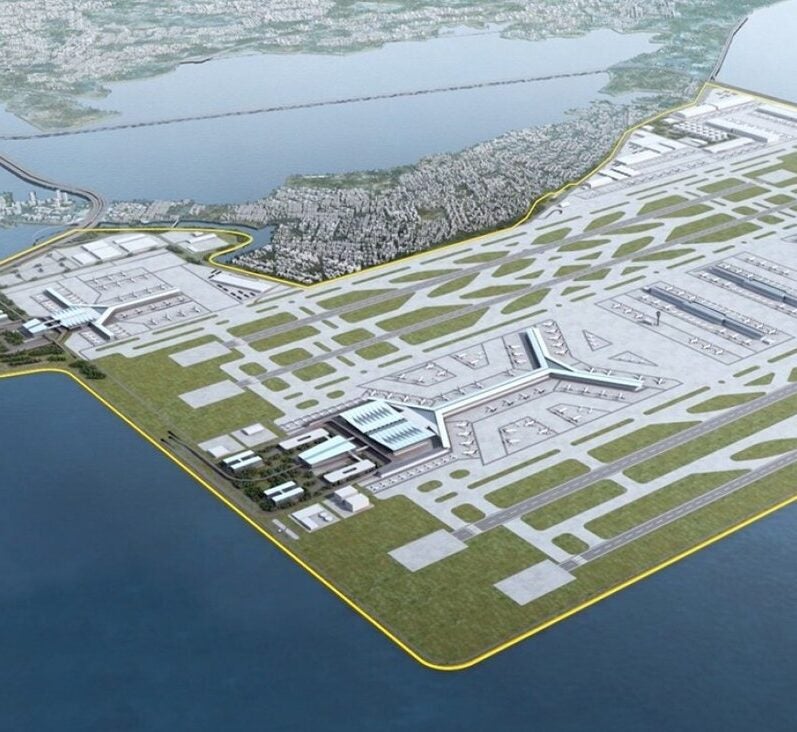
Sangley Point International Airport, Philippines: $10.3bn
The Philippines Department of Transportation, through The Provincial Government of Cavite, is undertaking the construction of an international airport in Cavite, Philippines.
The project involves the construction of an international airport, with a handling capacity of 130 million passengers per year on 1,500ha of land. It will redevelop the Sangley Point Naval Base in order to ease the congestion of Ninoy Aquino International Airport. The project will be developed in three phases.
The $4bn first phase includes the construction of the first runway and a terminal with a capacity of handling 25 million passengers per year. It also includes the construction of the Sangley connector road and bridge to connect the Kawit segment of the Manila-Cavite Expressway to the new airport.
The $6bn second phase will see the construction of two additional runways with an overall capacity of handling 75 million passengers per year. Finally, the third phase involves expanding to four runways, bringing the capacity to 130 million passengers per year.
The Sangley Point International Airport project includes the construction of four runways, taxiways, aprons, a terminal building, a cargo building, an air traffic control tower, and hangars. It also entails building new fire and rescue stations, parking spaces, and related infrastructure facilities. Further, the project will involve the installation of baggage handling systems, access control systems, communication systems, and safety and security systems.
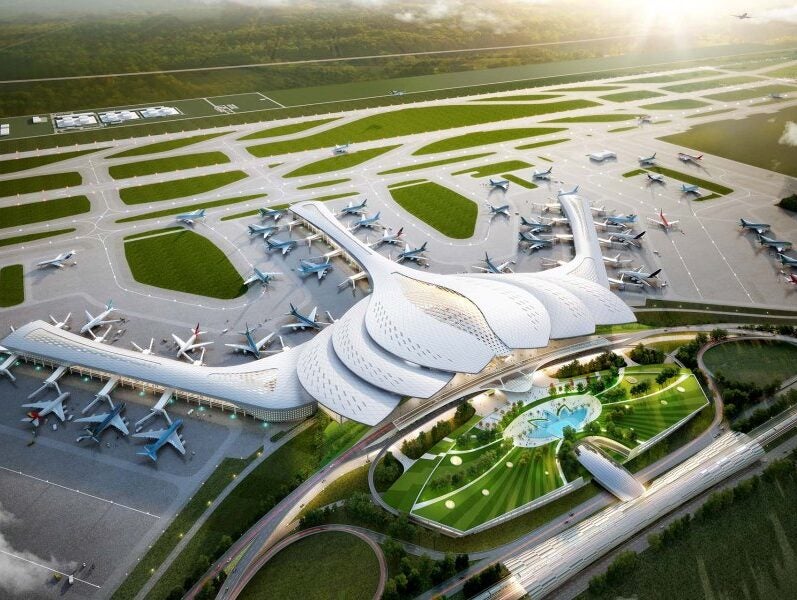
Long Thanh International Airport, Vietnam: $14.5bn
The Vietnam Ministry of Transport, through the Airports Corporation of Vietnam, is undertaking the construction of an international airport in Dong Nai, Vietnam. The airport will replace the Tan Son Nhat International Airport, which handles two-thirds of all international arrivals in Vietnam. The new airport has a planned capacity of 100 million passengers.
The project involves the construction of an international airport on 5,580ha of land, comprising 2,750ha for airport infrastructure, 1,050 ha for defence purposes, and 1,200 ha for supporting components and other commercial works.
Phase I of construction involves a 4,000m runway, with a width of 75m; and a 373,000m2 terminal building, along with other components that will be built to handle 25 million passengers and 1.2 million tonnes of cargo annually. It will be constructed in three sub-phases totalling a 2,500ha area.
The 1A subphase will include the construction of airport facilities with a capacity to handle up to 25 million passengers. Subphase 1B will include the construction of runways, parking lots for 34 aeroplanes and taxiways. The final subphase, 1C, will include the necessary facilities to be built and land-clearance for future purposes.
Phase II will increase the capability of handling passenger capacity to up to 50 million passengers and cargo capacity to 1.5 million tonnes per year, with the construction of one additional runway and one extra terminal. Lastly, Phase III will increase the handling capacity to 100 million passengers and five million tonnes of cargo a year through the construction of four additional runways.
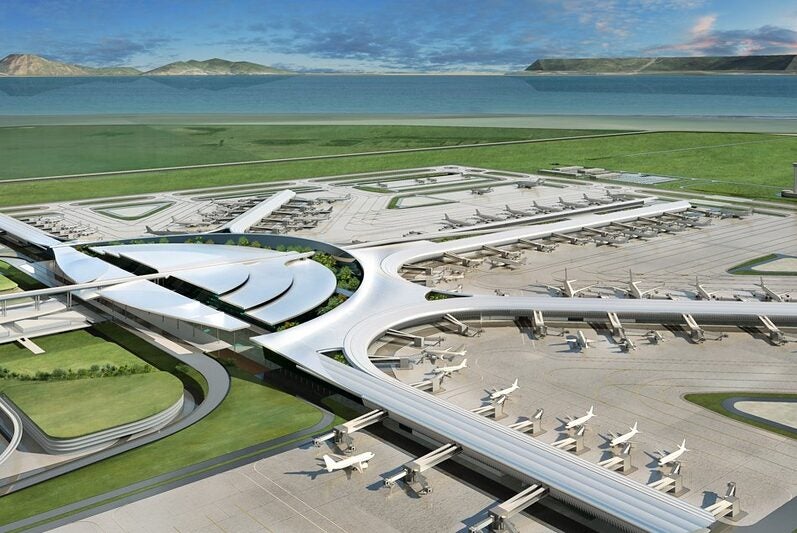
Bulacan International Airport, Philippines: $14.5bn
The Philippine Department of Transportation is constructing an international airport in Bulacan, Central Luzon, Philippines. This project, also known as New Manila International Airport, aims to generate over a million direct and indirect jobs, helping small industries in Bulacan and the neighbouring provinces.
The project involves the construction of an airport spanning 1,168ha, with four parallel runways, two pairs of 3.5km and 2.6km, and a provision for two more runways if required. An 8.4km airport toll road linking the airport to the North Luzon Expressway will be built, as well as a city complex on 1,332ha of land, a terminal building, and an administrative building.
The Bulacan International Airport project involves the construction of taxiways, an aircraft maintenance centre, an air traffic control tower, and control rooms. Lounges, passenger handling facilities, retail and parking facilities, will be built, as well as safety and security systems.
Once complete, the airport will have an initial capacity of 200 million passengers, which is about six times larger than the current capacity of Ninoy Aquino International Airport, the airport that is currently serving Manila and its surrounding metropolitan area. The project will serve as an alternative to the ageing Ninoy Aquino International Airport, which suffers from increasing congestion.
Read our updated list of the ten most expensive airport construction projects of 2022 here.





